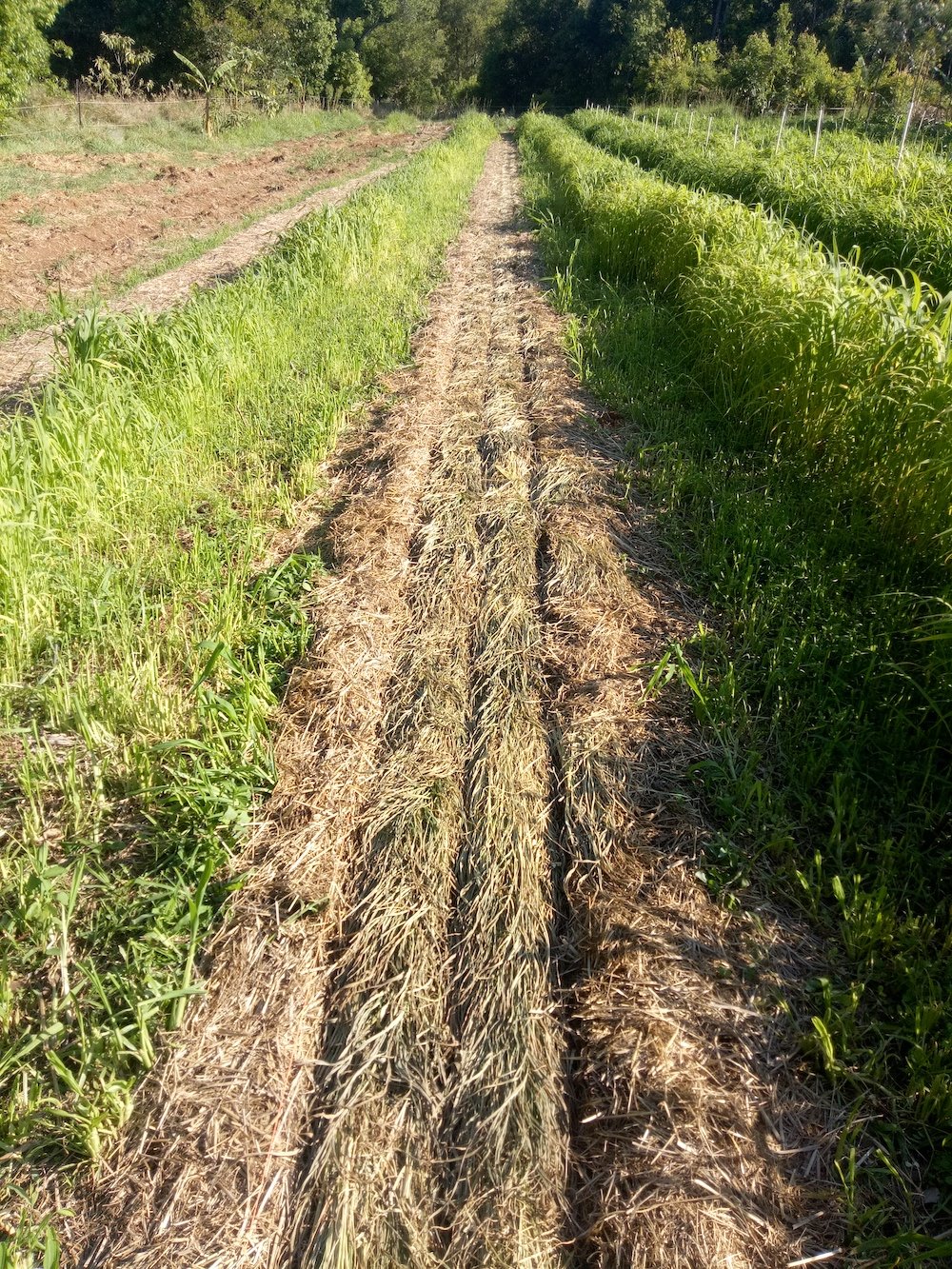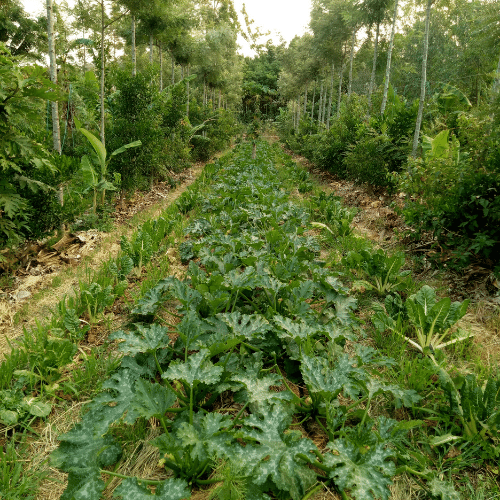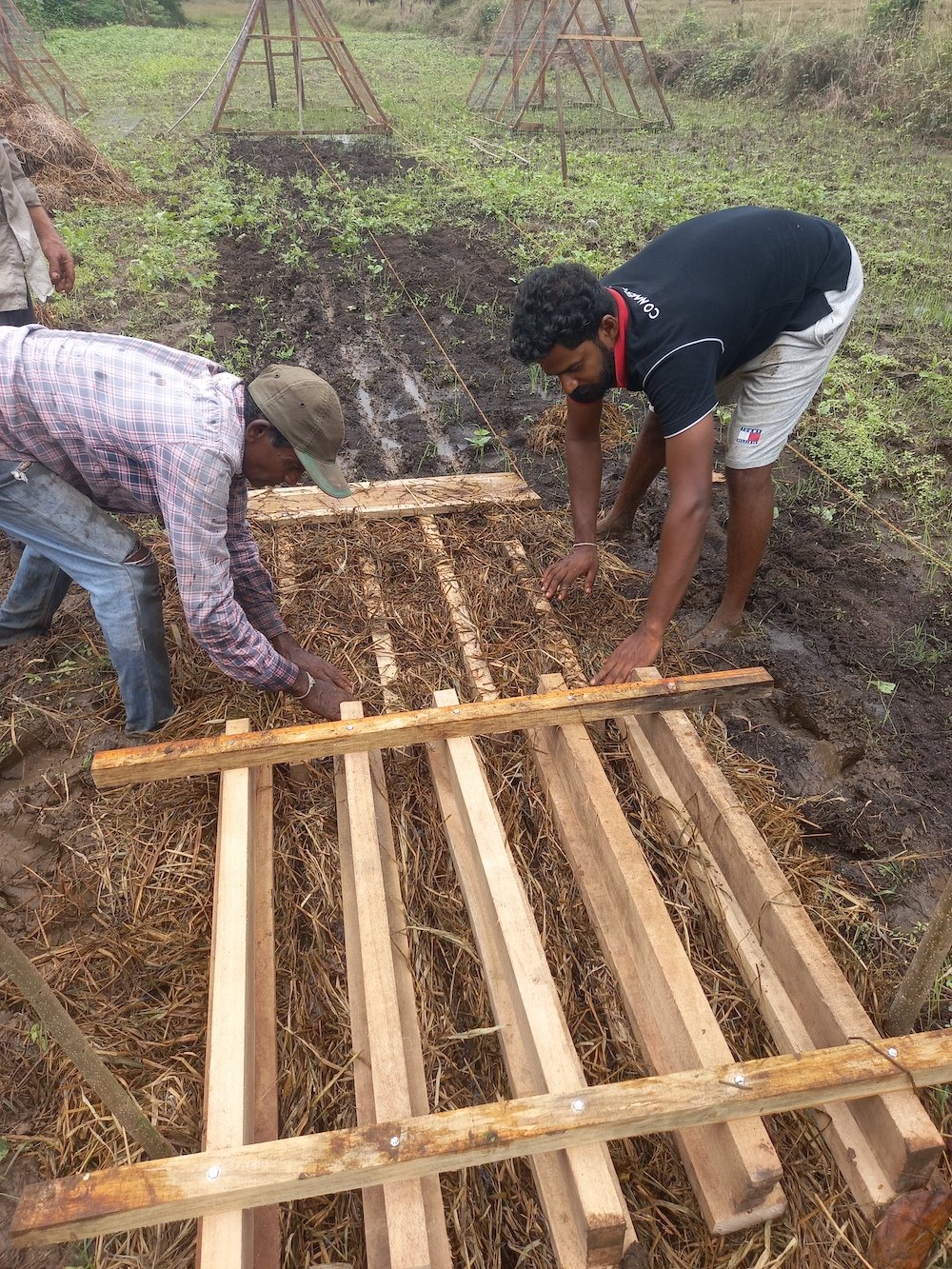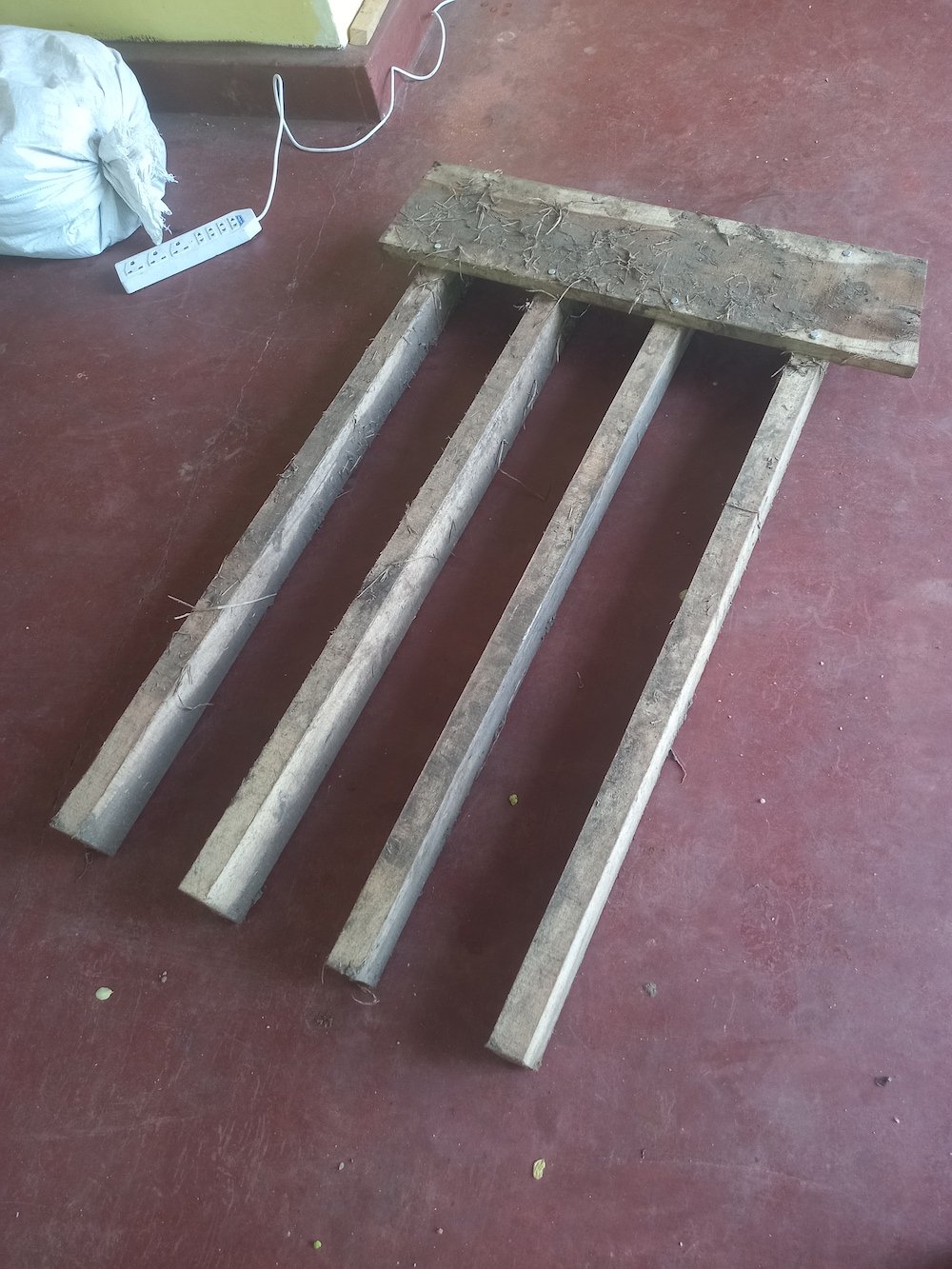
The MULCHATRON is a public domain design, free to share and develop, if you have any improvements or modifications, please consider joining The Syntropic Workshop for discussion and development, or please email your modifications to me and it will be published on this page.
MULCHATRON!
MULCHATRON!
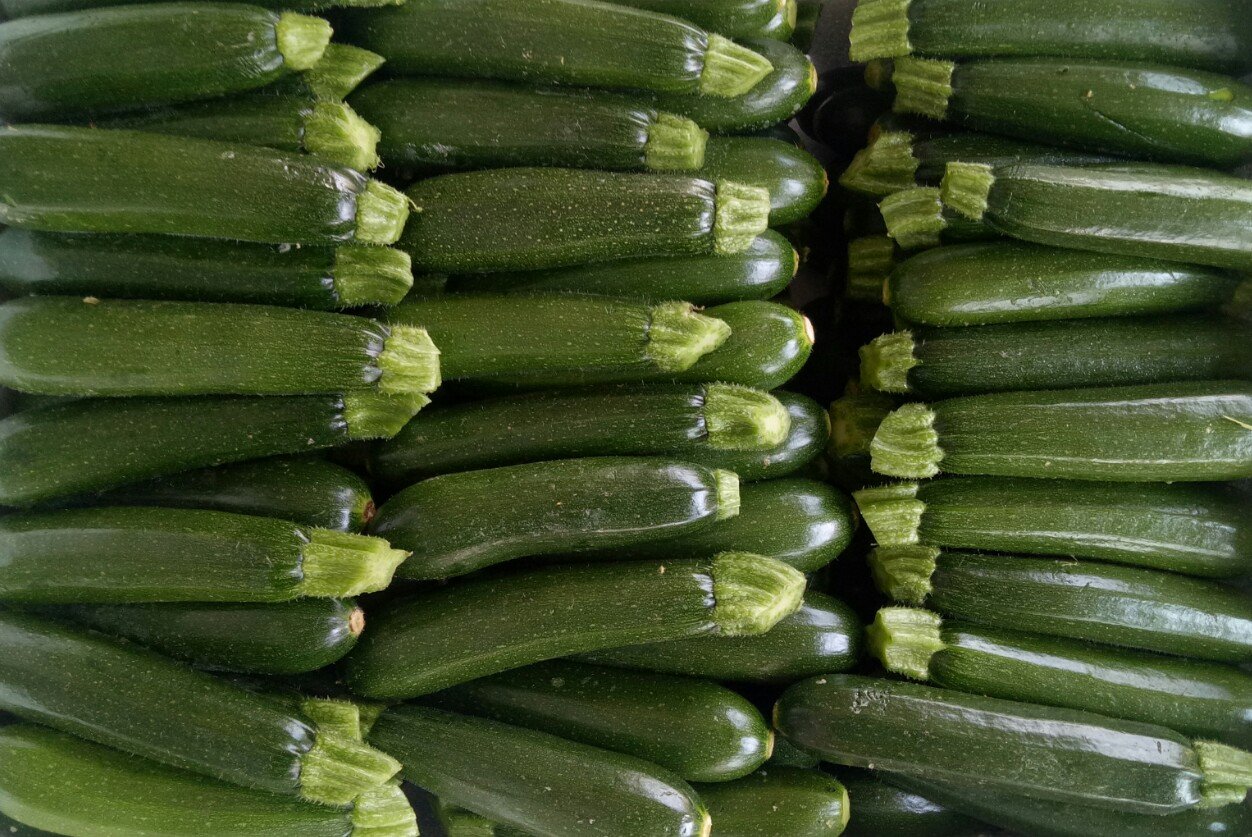
So What is the MULCHATRON and What is the Big Deal?
First up, the MULCHATRON achieves one extremely important criteria in regenerative agriculture - 100% soil cover, 100% of the time. In regenerative agriculture, this first milestone must be passed in order to go to the next higher levels. Once the soil is covered, positive feedbacks begin which takes our ecology higher and higher, faster and faster through species succession, this brings more photosynthesis, more life, more soil carbon, higher yields and a very robust ecology which is super resilient.
Newly prepared production area, all done precisely with the early version of the MULCHATRON
The MULCHATRON is a funny contraption, its obvious, simple and highly impactful, yet elusive and mundane to to those who have not confronted the problem of covering the soil at any level of scale, its a real crowd splitter - those that are impressed by it are the ones who have battled hard and in dedication to cover the soil with biomass and know the challenge well, whereas those who see it as nothing much, have not done the hours and truly experienced what it takes to cover the soil around plants. Our culture is more theoretical than practical and only hard hours in the field make the qualities of the MULCHATRON apparent.
It takes me a good solid 6 hours of work to mulch a 50 metre bed with 4 rows of crop by hand, this is back breaking work and I'm also reasonably fast and used to it, so needless to say, it is unviable to do this commercially, or even at a homestead level.
In this pic we can see 50 metre hand mulched rows, these were the early days, placenta 1 production to pay for costs, back breaking and time consuming work, but we refused to leave the soil bare and go the way of conventional organic production.
Here's another pic of the early agroforestry areas beginning with Placenta 1 vegetables to cover costs. It was very difficult and hard to maintain just this area, needless to say, the cost of management exceeded the income.
A close up of the work of the MULCHATRON!
This area quickly transformed, we immediately had a new problem to solve, which was to produce the biomass in situ, and essentially make the space fully syntropic. We redesigned the area to allow for biomass production and all of the other positive feedbacks associated with it. Planning to consciously follow an economic strategy, coupled with an ecological strategy of planting rows of vegetables this way to provide income and then later selecting every 3rd row for trees, with this paying its way and when its time to plant trees, all of the work is done and it becomes a simple exercise. This was the time when Henrique Sousa visited us from Brazil, and although it is a bit embarrassing and humbling to say, he told us that this is some of the best agroforestry he has seen - he walked through the rest of the established agroforestry approvingly - none of it was new to him though, but when he came to this part, he really lit up. He said it was better than most farms in Brazil, this was the moment where all of us involved took a minute to reflect on the 2 years of pain to get this far and considered how all of it was worthwhile.
Maud tending a newly planted vegetable consortium as we plant successionally down the field, with a broccoli (Di Ciccio) crop in full production in the background.
Incredibly satisfying way of farming, maximum photosynthesis, and almost 100% regenerated in situ, we used to add a small amount of chicken manure to each bed before planting. The efficiency on a true cost basis is the best that I have seen in this form of production.
Mini wobblers for irrigation, a handy consortium of lifecycle based succession - Radish and Lettuce, finishing with Di Ciccio broccoli.
An incredibly satisfying way to farm. A new crop of coriander can be seen germinating.
Openings in very deep and heavy mulch apparent after planting. Note the abundance of available biomass, as when a new crop is planted, only around 50% of new mulch is needed, as the old biomass from the old crop is recycled - it continues to become more efficient.
Laura picking magnificent cabbage in the early days when we could mulch at scale, before we added the biomass rows.
Luciana and Lucia Picking vegetables from the mulched areas for feeding students at our course with Namaste Messerschmidt.
A very successful summer consortium of Yin Choy, Lettuce and Thai Pink Egg Tomato. Here the Yin Choy is just about to be cut to make way for the Lettuce.
Newly planted consortium of Yin Choy, Lettuce and Thai Pink Egg Tomato.
Newly planted. Here you can see how little demand there is on the biomass rows due to the recycling of biomass from the previous crop.
Same row as above, but here you can see the new biomass in the centre and the older biomass pushed out to cover the shoulders. The MULCHATRON is very effective at facilitating this precise organisation.
Here is a later iteration of the MULCHATRON in action. You can see how simple it is, but there are some important nuances, which is the suspension and departure of the device from the mulch. It actually gets really tricky, because with some iterations of the MULCHATRON, it becomes critical as to what type of biomass you use, with the best being fresh cut green, laid down in swards like this. Chaotic piles of straw/hay etc become very difficult to use with the particular iteration in the above picture, but that's ok, because the basic do it yourself at home version, made out of wood, is like a universal multi fuel version, it is not as efficient as the one above, but the margin is not that big.
This row took Toby and Maud 40 minutes (1 hour, 20 minutes man hours) from start to finish, as you can see it is attached to a Chang seeder (a Chinese knock off of a Jang seeder), so it seeded as it mulched. If you remember at the beginning of this article, it took me 6 hours to do one 50 metre bed, so you can see the increase in efficiency - this works out as 4.5:1, with the seeder coupled to it it works out closer to 6:1, which puts the economics up there with conventional farming, especially when you consider the savings on weeding, water and soil amendments. When you think of this holistically, its a no brainer, it just takes a change of mindset and a different strategy.
Its the BEST FEELING to walk away from a sight like this knowing how well your crops will grow and how well protected they are, with way less maintenance, this is a much more stress free way of farming, once you learn how to deal with cutting yourself loose from the more common ways of farming and going ahead on your own.
Gudrun Gotsch visiting from Brazil, giving the MULCHATRON a try.
A bean crop in the Hawkesbury region planted with the MULCHATRON/seeder combo, here forest mulch from an arborist was used.
The Bean crop Growing.
In the system cutting back the surplus biomass supply to feed itself. This is Seteria grass (not the best biomass provider) being cut back in the middle of summer before running to seed.
IN THE AGROFORESTRY
The MULCHATRON has proven to be an excellent tool for inter row crops. Perfect for and perennial crops which want an early successional leader. The MULCHATRON will create a perfect space for seeds planted in heavy mulch, but the openings created are also superb for quick planting of seedlings, as you will probably know from experience, it adds a lot of time to seedling planting having to make an opening for every seedling. In the above pic, the MULCHATRON was used, and after that there was a follow up cut of biomass applied, as can be observed by the way the mulch is organised differently.
An inter row prepared with the MULCHATRON, with biomass supplied from within the rows.
Another agroforestry inter row planted with the MULCHATRON. With biomass supplied in situ as well as recycled biomass from the previous crop. Note that this is a spring planting, with the indication being the heavy frost damage visible on the bananas, which had yet to be managed. Also note the still producing cut and come again crop of Swiss Chard, planted as a "pasture crop" in the Panicum maximum.
Another inter row planted with the MULCHATRON, with the accompanying crop of Swiss Chard in the biomass rows.
It has been a long time since I have used the MULCHATRON for myself, and I miss it very much. The lack of use in my context is telling me that I still am not getting the most out of my farm - I still have some challenges to face, which mainly comes from not being able to get to my farm often enough, as when I'm in Australia I live a half hour drive away, plus I'm super busy getting other machinery built, this I have to do, because the blockages that the machinery remove are primary type 1 kind, I cannot move along further without new efficiencies being created by the tree row MULCHATRON, strip tiller and mini direct drill, plus the universal seed meter that I've designed. All of this machinery is developed to get agroforestry and regenerative agriculture up and running at a viable scale at a realistic cost - it doesn't need to be back breaking and ridiculously expensive, we just need to develop appropriate ways of implementing it. So without going to my farm every day, I cannot utilise the MULCHATRON in its full potential, and instead I focus on building biomass production and dividing Banana suckers and Taro pups. When the machinery is sorted, I will head back and get right into farming to the best potential. I honestly have to say I miss farming every day, but I understand if I get this other work done, it will open the way forward. I must be patient.
I am very very happy though, to be able to implement the utility of the MULCHATRON in Sri Lanka in a real context, as that's what I'm after. I don't feel good going around and demonstrating the MULCHATRON for the sake of novelty, as it is a bit impressive if you understand what it really does for those who choose to grow whilst covering the soil, but outside of that it can be, and has, been seen as just a tricky toy that a fellow is showing off, but it is far from that - it is a very important tool for people who are serious about covering the soil while growing. The context in the west is still not that supportive of this kind of application, because its not a big deal for most people or not to cover the soil - a lot of us, particularly those who are not growers simply look at it with detachment. BUT! in Sri Lanka, things are very, very different! Food is worth much, much more, and fertiliser prices are high, so any savings on the production side make a HUGE DIFFERENCE IN MARGINS!
This is a very special moment for me, as well as the farmers I'm working with, and here's why - firstly, I have been wanting to grow grains in covered soil for a long time (if we can get this right, it will be a big deal), particularly rice. Secondly, in Sri Lanka, nearly all rice is grown in paddys - this is because of weeds mostly. This system is only effective though, as long as there is a cheap supply of urea, as this system depends upon commercial fertiliser, it is this that makes the efficiency of weed free growing, without the urea the crops are poor. A rice paddy is anaerobic by nature, so it will not hold the type of soil microbes beneficial to healthy plant growth - rice has the ability to grow in these conditions and survive where the "competition" cannot thrive. The result of this is quite disappointing, as this way of growing depends on hybrid rice varieties, expensive commercial seed. This has all but stripped Sri Lanka of the traditional dry land rice varieties which underpin their culture, the varieties which come from, as the Singhala say - "the season of the king". Traditional dry land rice varieties from the past are diverse, and apparently they taste excellent, some of these include the famous Red Rice, and Black Rice. These varieties are becoming increasingly scarce, and it concerns not only myself, but many Sri Lankans, even the younger farmers. This is one of the reasons I am very excited right now, because if we can prove the utility of the MULCHATRON to support dry land rice production (the covered soil both preventing weeds and feeding the soil), we will have potentially made a breakthrough, particularly because the paddy way of growing is quickly becoming less viable as fertiliser costs continue to rise and the margins are being chewed to pieces, leaving farmers with dead fields (all of the organic matter that once provided natural nutrients being burned out by soluble nitrogen) and nowhere really to turn, and their precious dry land rice varieties from the season of the King being scarce, and difficult to grow in dead soil.
It turned out that the Uncle in Pihimbeergolawa had a stash of red rice seed! This for me was such a serendipitous moment, right as we were ready to implement the MULCHATRON, along with the deep context there, both culturally and in food sovereignty, and my desire to test this way of growing grain. I couldn't be more fortunate. All of us are very excited. We only have a small amount of Red Rice, but enough for the trial, and this will give us enough seed back to plant more and start the exponential process of change.
In the village of Pihimbeergolawa, a trial plot of culturally significant dry land red rice is being grown with covered soil thanks to the MULCHATRON
A LITTLE BIT MORE ABOUT THE MULCHATRON
So you have listen to me wax lyrically about the MULCHATRON and it's uses, but something else came about whilst this was being developed.
As I stood there with a friend of mine after we developed this and got the first working prototype to do the job, we looked at each other (my friend, Owen, is a very experienced farmer) and looked at the job it did, then considered the time it took, and we were both astonished that the solution was so simple, and, I have to say it, obvious.
We both lamented humanity, considering the at least 80 years (but much longer) we have been at full on war with weeds, working hell for leather, inventing more and more complex technology to maintain bare soil (robots, drones, herbicides and all those other huge expenditures which have paved the road to hell), plus all of the other expenditures to then counter the negative feed backs of bare soil.
The solution has always been to cover the soil.
But for some reason we found it too labour intensive and stopped bothering and then went the other way, spending much more resources and time than it takes to develop and build a MULCHATRON.
We both laughed and mourned the stupidity of our species, because we both knew it - in between us was the most ridiculously simple solution that we just both proved worked and was viable.
So the joke began - with all of the technology and resources involved in maintaining bare soil, and the strong bias toward technology we had the most anti tech, humble and ironically embarrassing alternative (it is at this point I want to say, that if you are serious about covering the soil, particularly with small crop, this is a REAL solution!)
"Hey Owen, this is really really hi tech shit bro, we have a technological revolution in front of us!" and that set the course for the name - the MULCHATRON.
"What do we call it?"
"Don't know, but it needs to sound really, really flash and hi tech"
"Oh yes, this is cutting edge"
"The CSIRO are going to be envious"
"Correct"
We eventually landed on the name - the "MULCHATRON 3000"
Yes, it is flash and hi tech, and it needs to sound like it. We agreed that it needs the 3000 added to the end for effect, we then worked out that 3000 means that, for in order to get to the year 3000, for humanity to survive that long, we need to be learn to cover the soil, otherwise we're stuffed.
So that's how the name came about, two ordinary farmers in the middle of nowhere found a way to cover the soil economically, cost effectively and increase production and increase fertility. We were genuinely embarrassed.
So what? it's just some bits of wood, what's the big deal? Well, that's up to the individual, and the ordinariness of this contraption set the way for the MULCHATRON to become a piece of cult farming equipment - those that absolutely love it, have seen it in action, and get the joke. Then there's those that are far from impressed "It's just some sticks of wood dude, so what?". If that is not the basis of a cult following I don't know what is - a cult following cannot exist without haters.
So the name "MULCHATRON 3000" is the best we could to to make a joke out if the whole thing.
And yes, the logo is as quirky as the name, but quite appropriate.
BUT WAIT, THERE'S MORE!
Just when you thought that this was going way too far, let me add another punchline.
THE MULCHATRON 3000 HAS A PATENT PENDING!
That's right, the ridiculously simple contraption made from hardware timber in its most basic farm is patented.
Why?
Well, we rocked up to teach a course some years ago, and for the practical, we of course had the MULCHATRON 3000 for planting.
But as we rolled it out, the host (a business man from Sydney) said WAIT!, STOP! and we all looked around in astonishment.
"Ok everyone, no photographs please, and please understand that this is important IP, so I ask you all to please keep this under wraps for now."
He then turned to me and told me that this is suuuuper important and very valuable - I argued that it was nothing more than an arrangement of some articulated pieces of steel (this was the newest manufactured version) and he told me that he's not letting me do anything else to share it until he brings his lawyers.
So a bit later on I find myself in the paddock in front of a patent lawyer showing him the ropes.
After explaining and demonstrating, he turns and say "well, I think that you have something".
I silently sat with the whole ridiculousness of the whole thing just deepening, the joke was getting funnier, all I wanted to do was be a farmer who covered the soil.
We had a bit of a talk and I had it explained to me that the patent is not about protection, it is about the fact that there is something valuable in the process, and that process is unique to my experience, and that experience and problem solving is where the value is, so with that in mind, there is opportunity for further innovation, and to do that you need to be financed, and to be financed you need to show value in many ways, and a good way is to hold a patent.
So there you go, an arrangement of sticks has a patent pending.
This is not for protection, I don't care about that, its free for anyone to make, why shouldn't it be?
But one thing that he was right about was the fact that the constant hours in the paddock, with a mind for solving problems, will yield value, and I think that this has been happening, as we formed a start up company to facilitate the building and testing of prototypes, and these things we do have - a tree row mulcher, a strip tiller, and a cool little mini direct seed drill. These contraptions are not as yet widely shared, but are known about in the back channels of the regen ag scene, and are attracting a lot of interest.
So, back to Australia soon to get back to playing with steel, and in some kind of fateful and poetic way I find my journey to Sri Lanka full of meaning about my own personal journey to solve problems in regenerative agriculture, with the most simplest of devices, to grow the humble crops and support one of the most humble yet meaningful jobs - the farmer. This can take us further into heavier, bigger pieces of steel driven by diesel horsepower, but I honestly don't think any of those things are as good as the MULCHATRON 3000.
Also, there is a mechanised version of the MULCHATRON 3000 on the drawing board.
Hoping to find my way back to the paddock sooner than later.
One more thing - "Why hasn't this already been thought of?"
It probably has.
Building and Operating the MULCHATRON
I'll start with the basic home made wooden version, I think that it is the best way - it costs very little and is very easy to make, after that one can then decide that the fabricated version which attaches to a push seeder may be a good long term option.
Here it is, basically a bunch of 100mx50mm (4"x2") hardwood just screwed together.
And this is the MULCHATRON in use.
The MULCHATRON is basically a frame that acts as a mask, and a stamp. First the frame with timbers set out to the same spacing as the rows covers the seed lines which allows a space for the seeds to germinate and emerge out of the mulch. Mulch is packed in between the timber boards, in between the seed rows. After that, the second part, the stamp, is then placed over the first frame, where the stamp pins down and squashes the mulch (works really well if the mulch is wet or damp). The first frame is then pulled out and slides forward over the next part to be mulched.
This is the first part, the essence of the device. These are the boards which keep the mulch from covering the seed lines, they are the right width to allow an opening for the seeds to emerge unrestricted from the thick mulch. Note how they are all attached to a wide piece of timber, this is so they are braced, they are fixed on with self tapping coach bolts so the fastening is very strong and resists any lateral forces which must be avoided, as this causes the boards to close together at the back and pick up mulch - the critical part of this function is a clean and clear exit from the mulch as it moves forward to the next section. The width of the rows can be crudely adjusted on this version by unscrewing the coach bolts and fastening them again to the front piece of the frame, for example, if you want 3 rows, unscrew the boards from the front timber and screw 3 pieces back on in the desired widths. You can of course make this as fancy as you want in your workshop and have it much easier to adjust.
Here is the stamp, it is in the position where it would be pinning down the last arrangement of mulch as the front "Mulchatron" component has been moved forward onto the next section. The stamp is very helpful, in some situations it can be omitted, but it makes a very big difference, where the end result are nice solid fat sections of mulch which are packed down and form an excellent cover over the soil between the lines.
Here it is being filled, with the stamp component sitting on the mulch from the last move - Chinthaka and VeeJay are operating the MULCHATRON like pro's. Check out Chinthaka's posture, standing straight legged, bent at the hips like a hinge and largely straight back, this is an excellent example of correct body use when working on the ground with your hands, like most farmers around the world do (although a lot of Asians squat), it allows you to reach very widely and quickly while being able to apply strength.
VIDEO
The Manufactured MULCHATRON
The manufactured MULCHATRON is a much more precise and efficient machine, but is really only necessary on more intensive horticultural operations. Because it also sows as you mulch, you completely cut the seed sowing task out of your bed set up, saving time and money. In this pic a bean crop is being sown.
Same bed with emerging bean crop.
Here's a video description of the finer nuances.
Thanks very much for reading!
If you would like to take your skills in regenerative agriculture and agroforestry to a higher level, please consider joining The Syntropic Workshop where we work as a community based on education and support. The Syntropic Workshop includes a hub of projects around the world which are seeing a lot of success. The Syntropic Workshop has seen many people save thousands of dollars in consultation fees and has enabled those to create their own solutions and reach a high standard. In the end, you are the solution - The Syntropic Workshop is all about getting YOU to the highest and best level.
Looking Ahead
Since the inception of the MULCHATRON, a team has formed of farmer engineers with a combine experience of over 80 years, to further solve problems facing regen ag, including the development of a tree row planting MULCHATRON which fixes to a tractor and can plant and mulch tree rows by the kilometre, saving tens of thousands of dollars, plus a specially designed strip tiller for improving the biomass production capacity and pasture cropping, also a mini disc direct drill, plus more.
Our start up company is designed to consolidate and attract resources to further break through and solve problems that come about from exciting new methods and technologies brought about by regenerative agriculture, this is a quickly growing space which will define how food is produced in the future. Perhaps you are looking for a regenerative investment and would like to join us? We have space for one more - just hit the contact button on the website header to get in touch.
Please sign up for updates either at the top or bottom of this page, or get in touch through the contact button for any inquiry.
Pioneering the way for small scale no till with the mini direct drill.

















